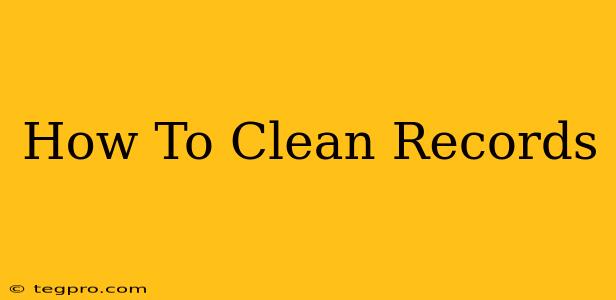So you've inherited your grandpa's record collection, stumbled upon a treasure trove at a flea market, or simply rediscovered your love for vinyl. But before you drop the needle, you need to know how to clean records. Dirty records can lead to pops, crackles, and a generally underwhelming listening experience. This comprehensive guide will walk you through the process, from simple home methods to more advanced techniques.
Why Clean Your Records?
Before diving into the cleaning methods, let's understand why cleaning your records is so crucial. Dust, fingerprints, and other debris accumulate on the vinyl surface, interfering with the stylus's ability to accurately read the grooves. This results in:
- Pops and crackles: These are the most common audio artifacts caused by dirt and debris.
- Reduced dynamic range: The subtle nuances and details in your music can be masked by surface noise.
- Potential damage to your stylus: Dirt can scratch and wear down your precious needle, shortening its lifespan.
- Improved sound quality: A clean record allows for a clearer, more accurate reproduction of the original recording.
Simple Home Methods for Cleaning Records
For a quick clean, especially for lightly soiled records, these methods are effective:
The Carbon Fiber Brush
This is the easiest and arguably most important tool in your arsenal. A carbon fiber brush gently sweeps away loose dust and debris before you even think about wet cleaning. Use it before and after any wet cleaning process.
The Microfiber Cloth
A soft, lint-free microfiber cloth is your best friend for removing any remaining dust after brushing. Gently wipe the record in a straight line, from the center outwards. Avoid circular motions, as these can leave streaks.
Advanced Record Cleaning Techniques
For records that require a more thorough cleaning, you'll want to consider a more involved process:
The Wet Cleaning Method
This method involves using a record cleaning solution and a specialized cleaning brush or vacuum system. There are many different types of record cleaning solutions on the market, so be sure to research and find one that suits your needs.
- The Process: Carefully apply the cleaning solution to the record, using the brush to agitate the solution and loosen embedded dirt. Then, thoroughly rinse the record with distilled water (tap water can leave mineral deposits) using the brush or vacuum system to remove the dirty solution. Finally, carefully dry the record with a microfiber cloth.
Record Cleaning Machines
For serious vinyl enthusiasts, a record cleaning machine represents the ultimate solution. These machines automate the process, providing a consistent and effective clean every time. They generally employ a vacuum system to remove the cleaning solution, ensuring a perfectly dry record.
Essential Tools for Record Cleaning
Gathering the right tools is key to achieving optimal results. Here’s a list of what you'll need:
- Carbon Fiber Brush: Essential for removing loose dust.
- Microfiber Cloths: Soft and lint-free for gentle wiping.
- Record Cleaning Solution: For deeper cleaning (optional for light cleaning).
- Record Cleaning Brush: For use with cleaning solution (optional, but recommended for wet cleaning).
- Record Cleaning Machine: For a professional-level clean (optional).
- Distilled Water: For rinsing after wet cleaning.
Protecting Your Clean Records
After all that hard work, you'll want to keep your records clean and in excellent condition. Here are a few tips:
- Handle records by the edges: Avoid touching the vinyl surface directly.
- Store records vertically: This prevents warping and minimizes damage.
- Keep records in protective sleeves: This helps to prevent dust and scratches.
- Use a quality record player: A well-maintained turntable will further protect your investment.
By following these steps, you can enjoy years of pristine playback from your cherished vinyl collection. Remember, patience and careful handling are essential for preserving the quality of your records. Happy listening!

